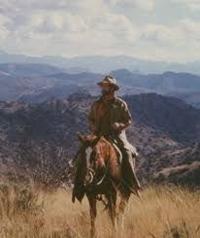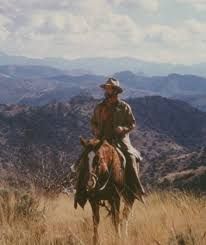Drummond Hadley said he wasn’t a cowboy poet — he was a poet who was also a cowboy.
Hadley, 77 and a longtime Southern Arizonan, died Nov. 26 at his mother’s family’s home in Cooperstown, New York. Following a long illness, his death closes a career that included five published books, study under some of poetry’s greatest names of the 1960s and ‘70s, four decades of ranching in the Arizona-New Mexico borderlands, and leadership of a pioneering conservation organization of the Southwest.
An heir of the Anheuser-Busch family of St. Louis, he found common ground with border-area residents of all incomes and backgrounds.
“It is amazing how a regular guy knew so many super poets,” said Ross Humphreys, owner of three Southern Arizona ranches.
Rio Nuevo Publishers, owned by Humphreys, published Hadley’s landmark 2005 collection, “Voice of the Borderlands,” which sought to tell of the region’s people and landscape through narrative poetry.
“When I got to know him, it was as a rancher interested in the environment,” Humphreys recalled. “Only when he came to me to publish his opus did I learn that he was also someone who did more than dabble in poetry. I didn’t know who he was and at what level he circulated among poets, even though I knew of his wealth,” said Humphreys, whose holdings include 30 square miles of the private and state-owned San Rafael Ranch in Santa Cruz County, where the movie “Oklahoma” was filmed in the 1950s.
Humphreys was speaking of Hadley’s longtime work and friendship with poets such as Allen Ginsberg, Gary Snyder and Lawrence Ferlinghetti, and his association with the late Charles Olson. Olson, who mentored Hadley’s work many years ago, was considered a bridge between classical, mid-20th century figures such as Ezra Pound and Williams Carlos Williams and New American poets of the ‘60s such as Ginsberg.
“He was a part of the poetry center community. He came to readings and was involved in some of our programs,” said Gail Brown, director of the University of Arizona Poetry Center from 2002 to 2013. “He was a great poet and a lover and supporter of poetry, and a good man. We are certainly going to miss him.”
Richard Shelton, a longtime Southern Arizona poet, author and a retired UA English professor, was director of the poetry center when Hadley was a UA student in the early 1960s. He took a dimmer view of Hadley’s poetry, but admired his ability to make the difficult leap into the cowboy’s world.
“He took some writing courses from me. I wasn’t crazy about his work. I knew him and his then-wife Diana socially ... Drummond was very good-looking and very charming ... He wanted desperately to be a cowboy, and he made it. It’s really hard to rope, very difficult, but he made it.”
Born in St. Louis County, Missouri, on May 27, 1938, Hadley attended schools in St. Louis and graduated from the private Pomfret Academy prep school in Connecticut in 1956. He earned a B.A. in English literature in 1962 and an M.F.A. in literature in 1965 from UA.
He started writing poetry during the early 1960s, and later was befriended by New American poets such as Snyder and Ginsburg. In the preface to “Voice of the Borderlands,” Hadley explained his entry into ranching at around the same time:
“In the early 1960s, I left academia and got a job as a cowboy in the Southwestern Borderlands,” he wrote. “I took these as given as I do now: that we are created in the image of the earth, and that we become what surrounds us.
“I wanted to explore the possibility that the language used by cowboys and vaqueros would reflect some essence of the rough mountains, mesas and arroyos of the Sonoran and Chihuahuan Deserts, in which they worked cattle and horses. I imagined that words might have an other than intellectual origin and understanding, that they might be rather of the body’s blood, the sweat and tears of loss and circumstance,” Hadley wrote.
In the 1960s, he worked as a cowboy on the Ella Dana and Dart ranches in Cochise County, Rancho San Bernardino in Sonora and the WS Ranch in northern New Mexico. In 1972, he moved with his family to Guadalupe Ranch in the Guadalupe Canyon area, a remote slice of southeast Arizona.
In the early 1990s, he and his neighbors and friends, including Warner and Wendy Glenn and Bill and Mary McDonald, helped establish the Malpais Borderlands Group. It’s a nonprofit organization dedicated to conservation ranching, fire ecology and open-space protection.
Around the same time, Hadley was instrumental in transferring the 272,000-acre Gray Ranch in the Animas Mountains in southwest New Mexico from the Nature Conservancy to the Animas Foundation, which he helped found.
By 2005, the Malpais Borderlands area encompassed 800,000 acres of private, federal and state land, and had developed an international reputation for trying to balance ranching and conservation, wrote Nathan Sayre in his book, “Working Wilderness: The Malpais Borderlands Group and the future of the Western Range.”
Sayre’s description of Hadley: “Poet, cowboy, iconoclast and visionary, he cultivated radical ideas about the land and an unusually broad circle of friends. Guadalupe Canyon became a cross between a laboratory and a salon.
“Drum managed his cattle to restore Guadalupe Creek by keeping them out of the riparian corridor during the summer, when young trees could establish. He rearranged his fences to make pastures reflect the landscape’s topography instead of ... section lines.
“In late night gatherings, he honed his ideas in conversations with ranchers, writers, conservationists and scientists,” Sayre wrote.
Hadley’s last book, “The Light Before Dawn,” published in 2012, was a foreshadowing of his demise. A reviewer for the website galatea resurrects described it as “the reflection book of someone entering the twilight of life that casts a new kind of shadow illuminating things and thoughts. There is a kind of narrative here in the best sense of story-telling; it is a flow toward knowing.”
He is survived by two former wives, Diana Hadley and Teresa Turner Hadley; three children, Lida, Seth and Sadie Hadley; and seven grandchildren. Private burial and a memorial service will take place on his Guadlupe Canyon Ranch. Memorial contributions may be made to the Animas Foundation, 14 Diamond A Drive, Animas, N.M. 88020.





